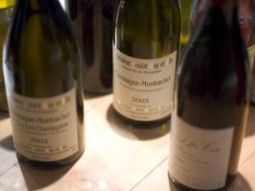List of French Wines
If you look at a list of French wines and don't have a clue what they mean, you've come to the right place. In the next few minutes we're going to explore the world of French wines and find out what differentiates a standard Burgundy wine from a classy Champagne - besides the price tag, of course!
Needless to say, French wines are the crème de la crop in world wines and have been for hundreds of years. What gives a true French wine its unmistakably superior aroma and taste? While you might assume it is the type of grapes used, such as Chardonnay, Cabernet Sauvignon, Sauvignon Blanc, Pinot Noir, or Merlot, that's not entirely true. In fact, for the French, the place of origin or wine region is the key to a great wine. Within France there are several main wine-producing regions - such as Bordeaux, Burgundy, Corsica, Alsace, Côtes du Rhone, Loire Valley, Rhone Valley, and Provence - which are noted next to a wine's name on a list of French wines. The quality of wine in each region is said to vary greatly, and certain wine producers in each region are held in higher regard than others.
 Photo by: pv
Photo by: pv
It is also common to see the mark "AOC" - standing for Appellation d'Origine Côntrolée - on a list of French wines. An appellation is a particular agricultural area within a geographical region in France. The marking signifies that the wine in question was grown in a certain region and has met certain standards. Burgundy in northeastern France, for example, is comprised of several appellations. If you see the word "Bourgogne" on a wine label, followed by "Blanc" or "Rouge," then what you have is a white or red wine from Burgundy. However some French wines actually list the name of the particular vineyard or village where the wine was produced, such as Premier and Grand Cru.
Don't know exactly what a Chardonnay or Pinot Noir is? It's actually quite simple! A Chardonnay is comprised entirely of white wine, while a Pinot Noir is 100% red wine. And now that you are becoming an expert in French wines, here are a few additional terms you will want to be familiar with:
- Vin rouge - Red wine
- Vin blanc - White wine
- Vin sec - Dry wine
- Vin doux - Sweet wine
After dinner drinks, known as a "digestif," are also popular in France. Brandies, or "eaux di vie," are common, such as Cognac, Armagnac, and Calvados, a French apple brandy from Normandy. Some restaurant owners even offer a glass of their own homemade brandy at the end of a meal - on the house!
Finally, once you have made a selection from the list of French wines and are ready for a toast, it's time to show off your "savoir faire" with one of the following French expressions:
- Sante! To health!
- A la votre! To yours! (meaning to your health)
- Tchin-tchin! An expression often uttered by the French before taking their first sip, referring to the noise of the glasses touching in a toast









New! Comments
Have your say about what you just read! Leave me a comment in the box below.